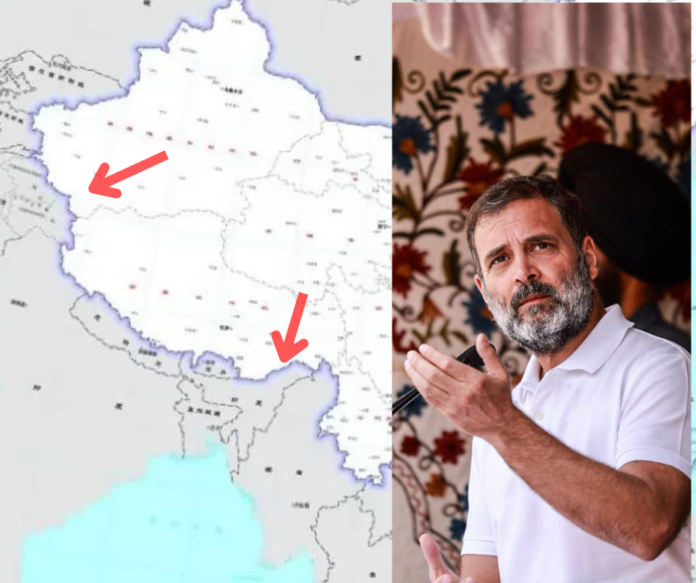China’s Ministry of Natural Resources released the map on the occasion of Surveying and Mapping Publicity Day. The freshly issued 2023 edition of the ‘standard map’ encompassed China’s assertions on Taiwan, and the inclusion of the nine-dash line, laying claim on a substantial portion of the South China Sea also includes Indian territories of Arunachal Pradesh and Aksai Chin.

Image: X/China 2023 Standard Edition Map (L) and Rahul Gandhi (R)
China released its 2023 edition of the “standard map,” laying claim over Arunachal Pradesh, Aksai Chin, Taiwan, and the disputed South China Sea.
Amid escalating tensions between India and China over territorial claims, Congress leader Rahul Gandhi accused Prime Minister Narendra Modi of misleading the nation regarding the ongoing land conflict in Ladakh.
Responding to China’s recent release of a “standard map” that includes regions from Indian territories, Gandhi urged the Prime Minister to address the serious issue.
Gandhi stated, “This map issue is very serious. They have taken away the land. PM should say something about it.” He emphasized that his recent visit to Ladakh confirmed that China had transgressed into Indian territory, contradicting the Prime Minister’s claims that not an inch of land had been lost.
The Congress party, in response to the inclusion of Arunachal Pradesh and Aksai Chin in China’s map, strongly objected to the move, emphasizing that these territories are an inseparable part of India. The party denounced the “habitual offender” for attempting to alter geographical realities through fabricated representations.
In response to the map, India lodged a strong diplomatic protest, categorically rejecting the claims as baseless. External Affairs Minister S Jaishankar labeled China’s assertions as “absurd claims” and reiterated that China’s history of releasing maps with inaccurate territorial delineations was well-known.
Jaishankar further explained that China’s habit of claiming territories that belong to other countries dates back to the 1950s, and their actions are not new. He affirmed that these territories are an integral part of India, and releasing maps would not change that fact.
The release of the “standard map” followed discussions between PM Modi and Chinese President Xi Jinping during the BRICS Summit in Johannesburg. The leaders had addressed the ongoing military standoff along the Line of Actual Control in eastern Ladakh.
This isn’t the first time China has attempted to assert control over disputed areas. In April, China renamed places in Arunachal Pradesh, prompting India to assert its sovereignty over the region.
As tensions continue to rise, the Ministry of External Affairs issued a stern protest against China’s claims. Meanwhile, Lt Gen P R Shankar, a military expert, emphasized the implications of China’s move. He highlighted that China’s new position, as conveyed through the map, designates previously disputed areas as sovereign to China. This has far-reaching implications, potentially justifying China’s use of force to defend its claims.
Experts caution that the release of the expanded map signals China’s intention to challenge international norms and establish its own set of rules. While the tensions persist, countries like India, Taiwan and across South China Sea are urged to explore new strategies to address the border issues, given China’s more aggressive stance.
In the larger context, the message is clear: China’s new claims and territorial assertions indicate a shift from being a competitor to an adversary for India. The situation underscores the need for India to develop new approaches for dealing with China’s expansionist ambitions.






